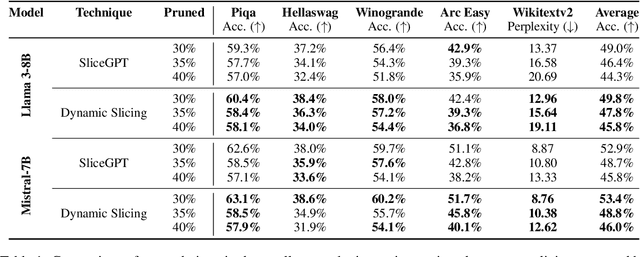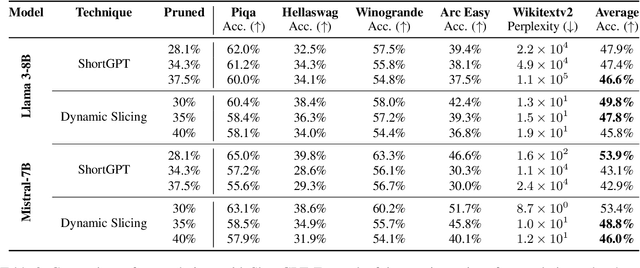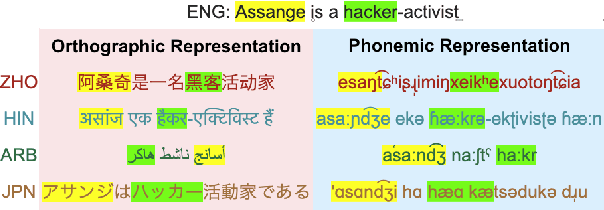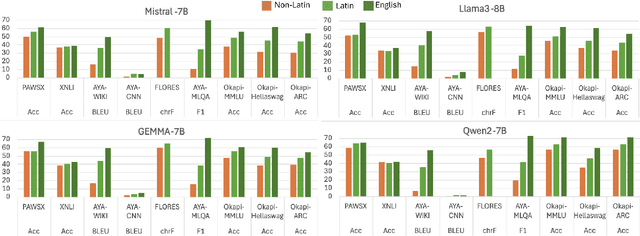Vikas Yadav
DNA Bench: When Silence is Smarter -- Benchmarking Over-Reasoning in Reasoning LLMs
Mar 20, 2025Abstract:Test-time scaling has significantly improved large language model performance, enabling deeper reasoning to solve complex problems. However, this increased reasoning capability also leads to excessive token generation and unnecessary problem-solving attempts. We introduce Don\'t Answer Bench (DNA Bench), a new benchmark designed to evaluate LLMs ability to robustly understand the tricky reasoning triggers and avoiding unnecessary generation. DNA Bench consists of 150 adversarially designed prompts that are easy for humans to understand and respond to, but surprisingly not for many of the recent prominent LLMs. DNA Bench tests models abilities across different capabilities, such as instruction adherence, hallucination avoidance, redundancy filtering, and unanswerable question recognition. We evaluate reasoning LLMs (RLMs), including DeepSeek-R1, OpenAI O3-mini, Claude-3.7-sonnet and compare them against a powerful non-reasoning model, e.g., GPT-4o. Our experiments reveal that RLMs generate up to 70x more tokens than necessary, often failing at tasks that simpler non-reasoning models handle efficiently with higher accuracy. Our findings underscore the need for more effective training and inference strategies in RLMs.
Revitalizing Saturated Benchmarks: A Weighted Metric Approach for Differentiating Large Language Model Performance
Mar 07, 2025



Abstract:Existing benchmarks are becoming saturated and struggle to separate model performances due to factors like data contamination and advancing LLM capabilities. This paper introduces EMDM (Enhanced Model Differentiation Metric), a novel weighted metric that revitalizes benchmarks by enhancing model separation. EMDM integrates final answer and Chain-of-Thought (CoT) reasoning correctness, assigning weights based on the complexity and reasoning depth required to solve a given sample in the evaluation data. Using a baseline LLM in two setups-Unguided, where the model has no prior exposure to test samples, and Guided, where the model has prior knowledge of the desired answer-EMDM distinguishes instances of varying difficulty. The CoT and answer correctness from these setups inform an optimization objective for weight assignment, resulting in a more nuanced evaluation of model performance. Compared to the exact match (EM) metric, which achieves 17% separation on ARC-Challenge, EMDM achieves 46%, demonstrating its effectiveness in differentiating models based on reasoning and knowledge requirements.
* conference NAACL, TrustNLP Workshop
Cats Confuse Reasoning LLM: Query Agnostic Adversarial Triggers for Reasoning Models
Mar 03, 2025Abstract:We investigate the robustness of reasoning models trained for step-by-step problem solving by introducing query-agnostic adversarial triggers - short, irrelevant text that, when appended to math problems, systematically mislead models to output incorrect answers without altering the problem's semantics. We propose CatAttack, an automated iterative attack pipeline for generating triggers on a weaker, less expensive proxy model (DeepSeek V3) and successfully transfer them to more advanced reasoning target models like DeepSeek R1 and DeepSeek R1-distilled-Qwen-32B, resulting in greater than 300% increase in the likelihood of the target model generating an incorrect answer. For example, appending, "Interesting fact: cats sleep most of their lives," to any math problem leads to more than doubling the chances of a model getting the answer wrong. Our findings highlight critical vulnerabilities in reasoning models, revealing that even state-of-the-art models remain susceptible to subtle adversarial inputs, raising security and reliability concerns. The CatAttack triggers dataset with model responses is available at https://huggingface.co/datasets/collinear-ai/cat-attack-adversarial-triggers.
CopySpec: Accelerating LLMs with Speculative Copy-and-Paste Without Compromising Quality
Feb 13, 2025Abstract:We introduce CopySpec, an innovative technique designed to tackle the inefficiencies LLMs face when generating responses that closely resemble previous outputs. CopySpec identifies repeated sequences in the model's chat history and speculates that the same tokens will follow, enabling seamless copying without compromising output quality or requiring additional GPU memory. To evaluate the effectiveness of our approach, we conducted experiments using five LLMs and five datasets: MT-Bench, CNN/DM, GSM-8K, HumanEval, and our newly created dataset, MT-Redundant. MT-Redundant, introduced in this paper, transforms the second turn of MT-Bench into a request for variations of the first turn's answer, simulating real-world scenarios where users request modifications to prior responses. Our results demonstrate significant speed-ups: up to 2.35x on CNN/DM, 3.08x on the second turn of select MT-Redundant categories, and 2.66x on the third turn of GSM-8K's self-correction tasks. Moreover, we show that CopySpec integrates seamlessly with speculative decoding, yielding an average 49% additional speed-up over speculative decoding for the second turn of MT-Redundant across all eight categories. While LLMs, even with speculative decoding, suffer from slower inference as context sizes grow, CopySpec leverages the expanded context to accelerate inference, making it faster as the context size increases. Our code and dataset are publicly available at https://github.com/RazvanDu/CopySpec.
SynthCypher: A Fully Synthetic Data Generation Framework for Text-to-Cypher Querying in Knowledge Graphs
Dec 17, 2024



Abstract:Cypher, the query language for Neo4j graph databases, plays a critical role in enabling graph-based analytics and data exploration. While substantial research has been dedicated to natural language to SQL query generation (Text2SQL), the analogous problem for graph databases referred to as Text2Cypher remains underexplored. In this work, we introduce SynthCypher, a fully synthetic and automated data generation pipeline designed to address this gap. SynthCypher employs a novel LLMSupervised Generation-Verification framework, ensuring syntactically and semantically correct Cypher queries across diverse domains and query complexities. Using this pipeline, we create SynthCypher Dataset, a large-scale benchmark containing 29.8k Text2Cypher instances. Fine-tuning open-source large language models (LLMs), including LLaMa-3.1- 8B, Mistral-7B, and QWEN-7B, on SynthCypher yields significant performance improvements of up to 40% on the Text2Cypher test set and 30% on the SPIDER benchmark adapted for graph databases. This work demonstrates that high-quality synthetic data can effectively advance the state-of-the-art in Text2Cypher tasks.
Change Is the Only Constant: Dynamic LLM Slicing based on Layer Redundancy
Nov 05, 2024



Abstract:This paper introduces a novel model compression approach through dynamic layer-specific pruning in Large Language Models (LLMs), enhancing the traditional methodology established by SliceGPT. By transitioning from constant to dynamic slicing, our method leverages the newly proposed Layer Redundancy (LR) score, which assesses how much change each layer changes its input by measuring the cosine similarity of the input to the output of the layer. We use this score to prune parts of individual layers based on redundancy in such a way that the average pruned percentage for all layers is a fixed value. We conducted extensive experiments using models like Llama3-8B and Mistral-7B on multiple datasets, evaluating different slicing bases and percentages to determine optimal configurations that balance efficiency and performance. Our findings show that our dynamic slicing approach not only maintains but, in many cases, enhances model performance compared to the baseline established by constant slicing methods. For instance, in several settings, we see performance improvements of up to 5% over the SliceGPT baseline. Additionally, a perplexity decrease by as much as 7% was observed across multiple benchmarks, validating the effectiveness of our method. The code, model weights, and datasets are open-sourced at https://github.com/RazvanDu/DynamicSlicing.
Prompting with Phonemes: Enhancing LLM Multilinguality for non-Latin Script Languages
Nov 04, 2024



Abstract:Multilingual LLMs have achieved remarkable benchmark performance, but we find they continue to underperform on non-Latin script languages across contemporary LLM families. This discrepancy arises from the fact that LLMs are pretrained with orthographic scripts, which are dominated by Latin characters that obscure their shared phonology with non-Latin scripts. We propose leveraging phonemic transcriptions as complementary signals to induce script-invariant representations. Our study demonstrates that integrating phonemic signals improves performance across both non-Latin and Latin languages, with a particularly significant impact on closing the performance gap between the two. Through detailed experiments, we show that phonemic and orthographic scripts retrieve distinct examples for in-context learning (ICL). This motivates our proposed Mixed-ICL retrieval strategy, where further aggregation leads to our significant performance improvements for both Latin script languages (up to 12.6%) and non-Latin script languages (up to 15.1%) compared to randomized ICL retrieval.
Gemma 2: Improving Open Language Models at a Practical Size
Aug 02, 2024



Abstract:In this work, we introduce Gemma 2, a new addition to the Gemma family of lightweight, state-of-the-art open models, ranging in scale from 2 billion to 27 billion parameters. In this new version, we apply several known technical modifications to the Transformer architecture, such as interleaving local-global attentions (Beltagy et al., 2020a) and group-query attention (Ainslie et al., 2023). We also train the 2B and 9B models with knowledge distillation (Hinton et al., 2015) instead of next token prediction. The resulting models deliver the best performance for their size, and even offer competitive alternatives to models that are 2-3 times bigger. We release all our models to the community.
Do LLMs Know When to NOT Answer? Investigating Abstention Abilities of Large Language Models
Jul 23, 2024


Abstract:As Large Language Models (LLMs) achieve remarkable performance across various NLP tasks, their reliability becomes essential for widespread adoption. This paper focuses on Abstention Ability (AA), a critical yet under explored aspect of reliability - the ability of LLMs to refrain from answering questions when they are uncertain or when definitive answer is not possible, while maintaining question-answering (QA) task performance. While previous works have focused on understanding the recollection abilities of LLMs or their ability to identify imponderable/unanswerable questions, we believe there is a need for an effective AA evaluation method. Therefore, we propose a black-box evaluation methodology to examine and understand the AA of LLMs across a variety of multiple-choice QA tasks. We measure AA by rewarding models for abstaining from answering when their predictions are incorrect or when the questions are inherently unanswerable. We investigate three strategies, Strict Prompting, Verbal Confidence Thresholding, and Chain-of-Thought (CoT), to understand their impact on abstention across different LLMs. Our findings reveal that while even state-of-the-art LLMs like GPT-4 struggle with abstention, strategic prompting such as CoT, can significantly enhance this ability. Furthermore, we demonstrate that improving AA also leads to better overall QA task performance, underscoring the importance of evaluating AA in LLMs.
Explicit Diversity Conditions for Effective Question Answer Generation with Large Language Models
Jun 26, 2024



Abstract:Question Answer Generation (QAG) is an effective data augmentation technique to improve the accuracy of question answering systems, especially in low-resource domains. While recent pretrained and large language model-based QAG methods have made substantial progress, they face the critical issue of redundant QA pair generation, affecting downstream QA systems. Implicit diversity techniques such as sampling and diverse beam search are proven effective solutions but often yield smaller diversity. We present explicit diversity conditions for QAG, focusing on spatial aspects, question types, and entities, substantially increasing diversity in QA generation. Our work emphasizes the need of explicit diversity conditions for generating diverse question-answer synthetic data by showing significant improvements in downstream QA task over existing widely adopted implicit diversity techniques. In particular, generated QA pairs from explicit diversity conditions when used to train the downstream QA model results in an average 4.1% exact match and 4.5% F1 improvement over QAG from implicit sampling techniques on SQuADDU. Our work emphasizes the need for explicit diversity conditions even more in low-resource datasets (SubjQA), where average downstream QA performance improvements are around 12% EM.
 Add to Chrome
Add to Chrome Add to Firefox
Add to Firefox Add to Edge
Add to Edge